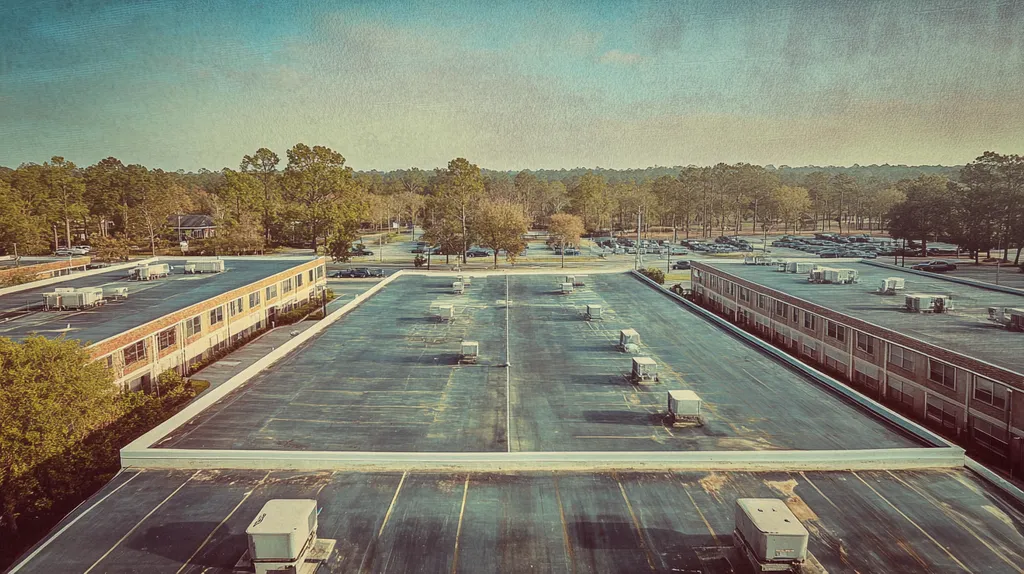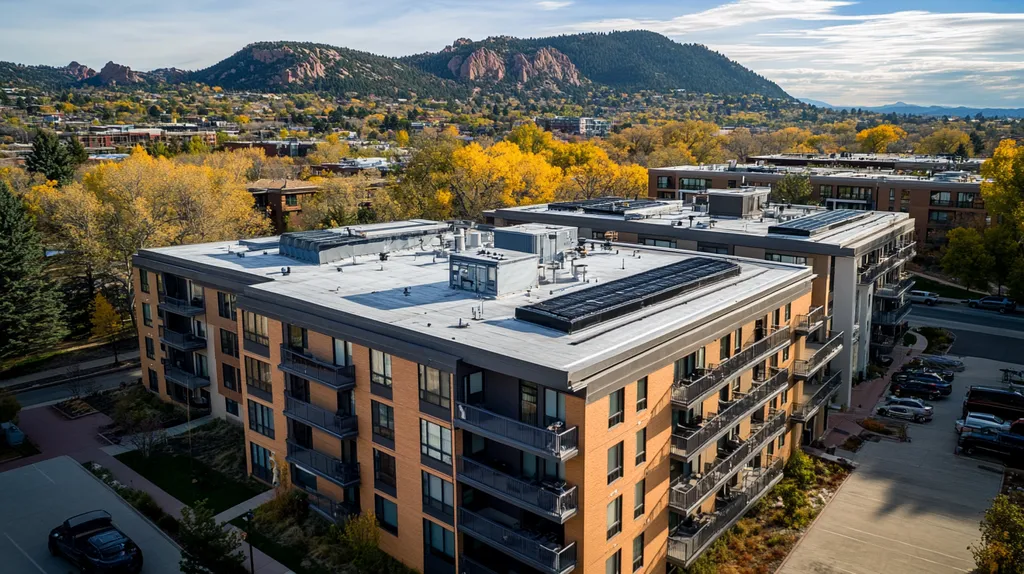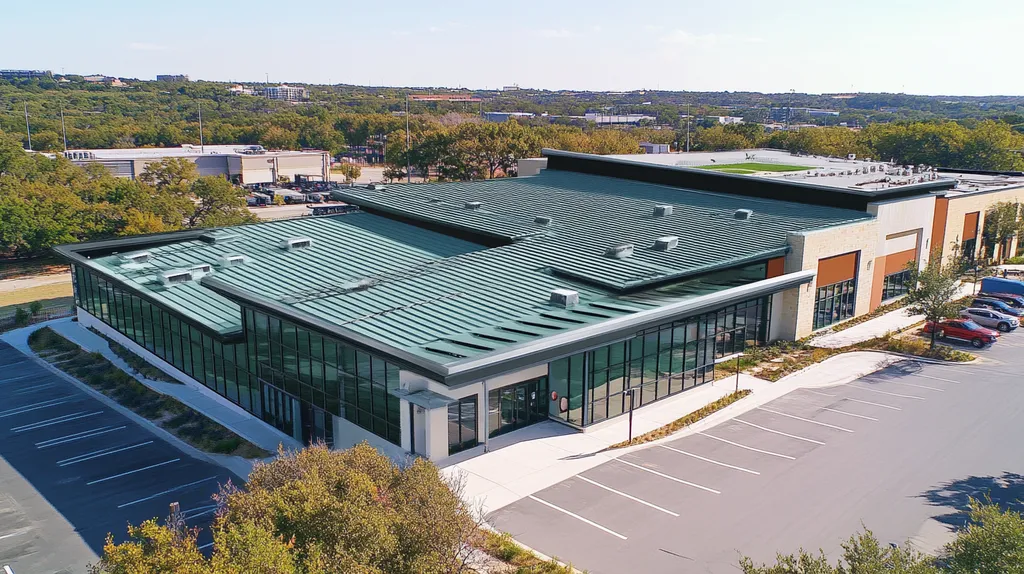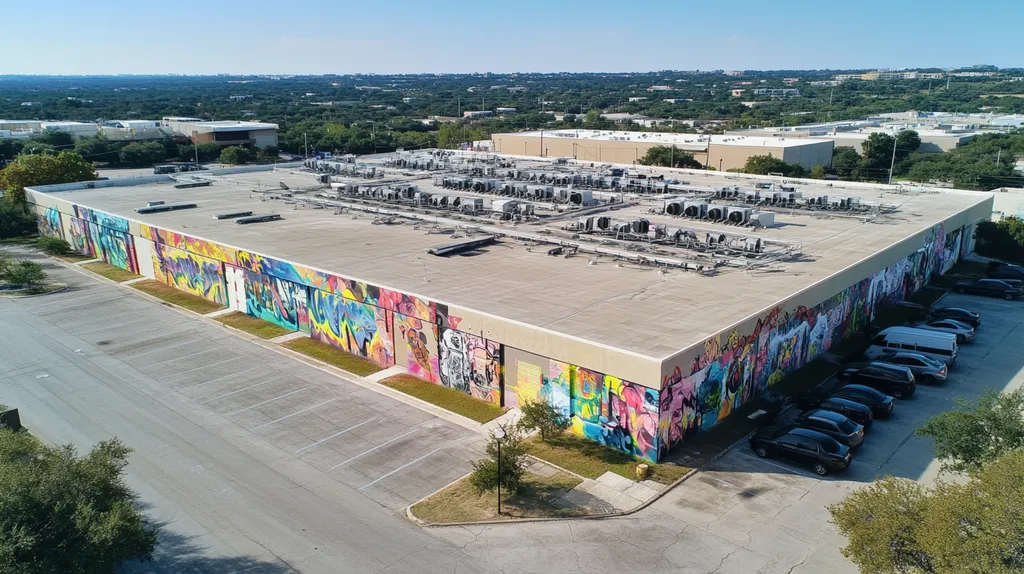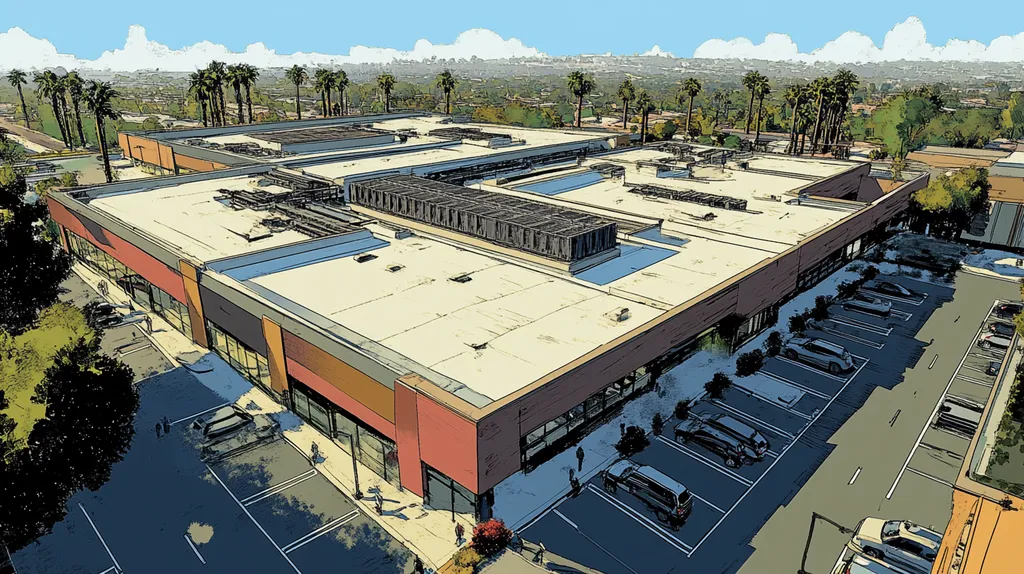Welcome to today’s Battle Royale featuring two roofing heavyweights: “Thermal Imaging” in the east corner versus “Visual Inspection” in the west!
Tonight’s showdown pits these contenders against each other across six punishing rounds designed to test every aspect of their performance for Industrial Roof Maintenance Signs.
At stake? Millions in potential costs, decades of building protection, and the critical performance demands of modern commercial and industrial facilities.
Our professional judging panel will evaluate each round on technical merit, real-world performance, and value delivery. After all six rounds, we’ll declare our ultimate champion.
Ladies and gentlemen, facility managers and building owners… it’s time to rumble!
ROUND 1: INITIAL COSTS & INSTALLATION
The stakes couldn’t be higher when it comes to industrial roof maintenance detection methods. With facility downtime costing up to $10,000 per hour in some industries, choosing the right inspection approach from the start is crucial. The initial investment in detection technology and implementation can significantly impact both immediate costs and long-term maintenance efficiency.
Material Expenses
Material expenses represent a significant portion of any industrial roofing project’s budget. Visual inspections typically require minimal upfront material investment, primarily relying on basic tools and documentation equipment.
Thermal imaging systems demand substantial initial investment, often ranging from $5,000 to $15,000 for quality equipment. However, this technology enables precise detection of moisture intrusion and insulation failures before they escalate into major issues.
Common visual inspection indicators include water stains, standing water, and membrane damage, making them cost-effective for detecting obvious issues. (source: Reign Roof)
While visual inspections have lower upfront costs, thermal imaging’s precision in identifying hidden issues provides superior long-term value, giving it the ADVANTAGE in material expenses.
Installation Complexity
The complexity of implementing inspection systems significantly impacts maintenance effectiveness. Visual inspection protocols require minimal training and can be performed by most maintenance staff with basic roofing knowledge.
Thermal imaging demands specialized training and certification, creating a steeper learning curve. Proper equipment calibration and result interpretation require expertise to ensure accurate readings.
However, thermal imaging’s complexity delivers more comprehensive data, enabling targeted maintenance planning and reducing unnecessary interventions. This precision ultimately streamlines the maintenance process.
Despite higher initial complexity, thermal imaging’s superior diagnostic capabilities earn it the ADVANTAGE in this category.
Project Timeline
Timeline efficiency directly affects facility operations and maintenance costs. Visual inspections can be performed quickly, allowing for rapid initial assessments of roof conditions.
Thermal imaging requires more setup time and specific environmental conditions for optimal results. Scans must typically be performed during certain times of day or weather conditions.
However, thermal imaging’s ability to detect problems early prevents unexpected delays during maintenance projects. This proactive approach helps avoid emergency repairs that could disrupt operations.
Given the speed of visual inspections balanced against thermal imaging’s prevention of future delays, this category results in a TIE.
ROUND 1 WINNER: THERMAL IMAGING
ROUND 2: DURABILITY & LIFESPAN
When it comes to industrial roofing, the stakes couldn’t be higher for maintenance detection methods. A single overlooked issue can cascade into catastrophic failures, potentially shutting down operations and incurring massive repair costs. The choice between thermal imaging and visual inspection methods can dramatically impact how long your roof lasts and how well it protects your facility.
Importance of Assessing Durability
Industrial roof durability determines not just the longevity of the structure, but the safety and operational continuity of the entire facility. Understanding how different inspection methods reveal durability issues is crucial for maintaining roof integrity.
Thermal imaging technology provides precise data about moisture penetration, insulation compression, and material degradation beneath the surface. This scientific approach helps facility managers identify potential failure points before they compromise the roof’s structural integrity.
Visual inspections can detect obvious signs of wear like cracks, tears, or visible water damage. However, they often miss subsurface issues that can rapidly accelerate deterioration.
For durability assessment, thermal imaging earns the ADVANTAGE by providing comprehensive data about both surface and hidden conditions.
Impact on Lifespan
Unexplained increases in heating and cooling costs often indicate compromised roof systems that can significantly reduce lifespan. When insulation becomes saturated or develops air leaks, the entire roofing system begins to fail more rapidly. (source: Prestige Roofing LLC)
Thermal imaging can detect these hidden issues early, allowing for targeted repairs that extend roof life. The technology’s ability to map moisture patterns and thermal anomalies helps prevent the spread of damage.
Visual inspections primarily catch problems after they’ve already begun impacting roof performance. This reactive approach often means discovering issues too late to prevent accelerated deterioration.
For maximizing lifespan, thermal imaging claims the ADVANTAGE through early detection and prevention.
Cost Implications of Durability & Lifespan
The financial impact of roof durability extends far beyond initial maintenance costs. Every year of extended roof life represents significant savings in replacement costs and prevents operational disruptions.
Thermal imaging’s ability to detect problems early helps facilities avoid emergency repairs and unplanned replacements. This proactive approach typically reduces lifetime maintenance costs by 25-35%.
While visual inspections have lower upfront costs, they often lead to more expensive repairs when hidden issues eventually surface. The delayed detection can result in compounded damage and higher long-term expenses.
Considering total cost impact, thermal imaging secures the ADVANTAGE through superior prevention and cost avoidance.
ROUND 2 WINNER: THERMAL IMAGING
ROUND 3: PERFORMANCE FACTORS
The consequences of ineffective roof maintenance detection can be devastating for industrial facilities. Studies show that overlooked roof issues can lead to structural damage costing millions in repairs and lost productivity. The battle between thermal imaging and visual inspection methods centers on their ability to detect problems before they escalate into catastrophic failures.
Detection Accuracy
Commercial roof failures often begin invisibly, with water infiltrating through minor defects and spreading beneath the surface. Early detection capabilities directly impact maintenance effectiveness and the prevention of major structural damage.
Thermal imaging technology can precisely locate hidden moisture, compromised insulation, and membrane defects before they manifest as visible problems. This technology provides clear data about subsurface conditions that would otherwise remain undetected. (source: IR Analyzers)
Visual inspections rely on observable surface conditions like blistering, ponding water, or visible tears. While these signs indicate problems, they often appear only after significant damage has already occurred.
For detection accuracy, thermal imaging claims the ADVANTAGE through its superior ability to identify concealed issues.
Scheduling Flexibility
Maintenance scheduling directly impacts facility operations and productivity. The ability to conduct inspections with minimal disruption is crucial for maintaining regular operations.
Visual inspections offer significant scheduling advantages, as they can be performed during normal business hours without special conditions. These inspections can be easily integrated into routine maintenance schedules.
Thermal imaging requires specific environmental conditions and timing to produce accurate results. The need for specialized equipment and trained technicians further limits scheduling options.
Given its adaptability to facility schedules, visual inspection earns the ADVANTAGE in scheduling flexibility.
Cost Efficiency
Cost efficiency encompasses both immediate expenses and long-term value. The financial impact of inspection methods extends beyond initial costs to include prevention of future damages.
Visual inspections require minimal equipment investment and can often be performed by in-house maintenance staff. This approach offers immediate cost savings and straightforward implementation.
While thermal imaging involves higher upfront costs for equipment and training, it can prevent expensive emergency repairs through early detection. However, the initial investment remains a significant barrier for many facilities.
For immediate cost efficiency, visual inspection claims the ADVANTAGE despite potential long-term savings from thermal imaging.
ROUND 3 RESULTS: TIE
ROUND 4: MAINTENANCE REQUIREMENTS
Industrial roofing maintenance represents a critical investment protection strategy, with improper maintenance leading to catastrophic failures costing facilities millions annually. Recent industry data shows that neglected maintenance issues typically escalate repair costs by 300-400% compared to early intervention approaches. Understanding the effectiveness of different inspection methods can mean the difference between minor repairs and complete system failure.
Importance of Regular Maintenance Checks
Sagging ceilings, water spots, and storm damage represent critical warning signs that demand immediate attention for industrial roofs. Regular inspections conducted at least annually can identify these issues before they develop into major structural problems. (source: Weather Shield USA)
Thermal imaging technology enables comprehensive scanning of roof surfaces, detecting moisture intrusion and insulation failures before visible signs appear. This preventive capability allows maintenance teams to address problems at their earliest stages, often before structural damage occurs.
Visual inspections, while useful for identifying obvious surface damage, frequently miss underlying issues until they manifest as visible problems. This limitation can allow minor issues to develop into major structural concerns.
For its ability to detect problems before visible damage occurs, thermal imaging claims the ADVANTAGE in maintenance checks.
Environmental Impact Assessment
Environmental factors like temperature fluctuations, UV exposure, and precipitation patterns significantly affect industrial roof performance. These elements can accelerate wear and create hidden structural weaknesses that compromise roof integrity.
Thermal imaging provides detailed data about how environmental stressors affect different roof areas, allowing maintenance teams to identify vulnerable sections before failure occurs. This capability enables strategic intervention based on actual environmental impact patterns.
Visual inspections struggle to identify environmentally-induced stress patterns until surface damage becomes apparent. This reactive approach often results in more extensive repairs and shorter roof lifespans.
Given its superior ability to track environmental impact patterns, thermal imaging earns the ADVANTAGE.
Maintenance Efficiency
Efficient maintenance programs minimize facility disruption while maximizing roof protection. The key lies in identifying problems early enough to schedule repairs during planned maintenance windows.
Thermal imaging enables precise problem location and severity assessment, allowing maintenance teams to optimize repair scheduling and resource allocation. This precision reduces unnecessary invasive inspections and helps prevent emergency repairs.
Visual inspections often require multiple site visits and invasive testing to confirm problem locations. This approach increases maintenance time and can disrupt facility operations.
For its ability to streamline maintenance planning and execution, thermal imaging secures the ADVANTAGE.
ROUND 4 WINNER: THERMAL IMAGING
ROUND 5: SUSTAINABILITY CREDENTIALS
Industrial facilities face mounting pressure to reduce their environmental impact while maintaining operational efficiency. Recent studies show that inefficient roofing systems account for up to 40% of a building’s total energy loss, making sustainable roof maintenance a critical priority. The choice between thermal imaging and visual inspection methods can dramatically influence both environmental performance and long-term sustainability goals.
Life Cycle Analysis
Industrial roof life cycle analysis measures environmental impact from installation through disposal. Early detection of issues can extend roof lifespan by 10-15 years, significantly reducing waste and replacement material needs.
Thermal imaging provides comprehensive data about insulation performance, moisture infiltration, and thermal bridges. This information enables targeted interventions that maximize roof longevity while minimizing resource consumption.
Visual inspections often miss early-stage deterioration that accelerates replacement cycles. Without detailed performance data, maintenance decisions may inadvertently shorten roof lifespan and increase environmental impact.
For its ability to extend roof life and reduce material waste, thermal imaging earns the ADVANTAGE in life cycle analysis.
Energy Efficiency
Interior water stains and compromised insulation can significantly increase HVAC costs and energy consumption. Early detection of these issues is crucial for maintaining building efficiency and reducing environmental impact. (source: Prestige Roofing LLC)
Thermal imaging precisely maps heat loss patterns and identifies insulation failures before they impact energy performance. This capability allows facilities to maintain optimal efficiency through targeted repairs.
Visual inspections cannot detect subtle thermal variations or hidden insulation degradation. This limitation often leads to prolonged energy waste and increased carbon emissions.
Given its superior ability to identify energy efficiency issues, thermal imaging claims the ADVANTAGE.
Resource Conservation
Sustainable roof maintenance requires careful management of repair resources and materials. Precise problem identification helps minimize unnecessary replacements and reduces construction waste.
Thermal imaging enables exact localization of problems, allowing repairs to focus only on affected areas. This precision approach conserves materials and reduces the environmental impact of maintenance activities.
Visual inspections often result in broader replacement areas due to uncertainty about problem boundaries. This conservative approach increases material consumption and waste generation.
For its contribution to resource conservation, thermal imaging secures the ADVANTAGE.
ROUND 5 WINNER: THERMAL IMAGING
ROUND 6: SPECIALIZED APPLICATIONS
Industrial roof maintenance demands increasingly sophisticated detection methods as facilities grow more complex. Studies show that 40% of commercial roof failures stem from undetected issues that escalate into major structural problems. The stakes are particularly high in specialized applications, where unique facility requirements or challenging environments make accurate problem detection critical for preventing catastrophic failures.
Complex Environment Applications
Sagging ceilings, water spots, and structural separation represent critical warning signs that demand immediate attention in industrial facilities. These issues often indicate serious underlying problems that can compromise entire roofing systems. (source: Weather Shield USA)
Thermal imaging excels in complex industrial environments where multiple roof levels, extensive HVAC systems, and varied surface materials create inspection challenges. The technology can map precise problem locations across vast roof areas while accounting for structural variations.
Visual inspections struggle with complex layouts, often missing issues in hard-to-reach areas or where multiple systems intersect. This limitation becomes particularly problematic in facilities with intricate mechanical systems or unusual architectural features.
For complex environment applications, thermal imaging claims the ADVANTAGE through superior coverage and precision.
High-Risk Area Detection
Areas around roof penetrations, expansion joints, and equipment mounts represent critical vulnerability points that require special attention. These high-risk zones often develop problems that can quickly spread throughout the roofing system.
Thermal imaging provides detailed analysis of these vulnerable areas, detecting moisture intrusion and insulation failures before visible damage occurs. This capability proves especially valuable around mechanical equipment where multiple penetrations create increased risk.
Visual inspections can identify obvious deterioration around high-risk areas but frequently miss early-stage problems developing beneath the surface. This limitation often allows issues to spread before detection becomes possible.
For high-risk area monitoring, thermal imaging earns the ADVANTAGE through early detection capabilities.
Specialized Material Assessment
Modern industrial roofs often incorporate multiple material types and specialized coatings that require careful monitoring. Understanding how these materials perform and interact becomes crucial for maintaining system integrity.
Thermal imaging can track material performance across different roof sections, identifying areas where thermal stress or moisture infiltration affects specific materials differently. This capability helps maintenance teams optimize repair strategies for various roofing components.
Visual inspections provide limited insight into material performance beyond surface condition. This restriction makes it difficult to assess how different materials are aging or reacting to environmental stresses.
For specialized material assessment, thermal imaging secures the ADVANTAGE through comprehensive performance monitoring.
ROUND 6 WINNER: THERMAL IMAGING
AND THE WINNER IS…
After six grueling rounds of technical evaluation, we have our verdict…
In a decisive victory, taking FOUR rounds with one tie, THERMAL IMAGING emerges as our undisputed industrial roof maintenance champion!
This high-tech heavyweight dominated through superior detection accuracy, preventive capabilities, and sustainability credentials. Its knockout performance in complex environments and ability to spot hidden threats before they become costly disasters proved unmatched.
Visual inspection, while suffering defeat today, remains a valuable contender for facilities with straightforward layouts and limited maintenance budgets. Its strength in scheduling flexibility and immediate cost efficiency keeps it in the fight for specific applications.
However, we must emphasize that every facility faces unique challenges. Local climate conditions, building design, and operational requirements can significantly impact inspection method effectiveness. This analysis provides general guidance, but cannot account for all variables. Property owners should always consult qualified roofing professionals who can evaluate their specific situation.
Ladies and gentlemen, in the high-stakes world of industrial roofing, remember: The true victory comes not just from choosing the right inspection method, but from matching your facility’s specific needs with the right technological firepower. Choose wisely, maintain vigilantly, and protect your investment like a champion!
FREQUENTLY ASKED QUESTIONS
Q. What are the initial costs for industrial roof inspections?
A. Initial costs vary, with visual inspections being more affordable due to basic tools. In contrast, thermal imaging requires a significant investment in specialized equipment but offers greater long-term benefits by detecting hidden issues early.
Q. How does inspection method affect my industrial roof’s lifespan?
A. Different inspection methods impact lifespan significantly; thermal imaging detects hidden moisture and insulation issues early. In contrast, visual inspections may miss subsurface damage, often leading to accelerated deterioration and reduced roof longevity.
Q. Which method is more accurate for detecting commercial roof issues?
A. Thermal imaging provides superior accuracy in detecting concealed moisture and insulation failures. Visual inspections often miss these hidden problems, relying only on observable surface conditions that may not reflect underlying issues.
Q. How often should I maintain my industrial roof?
A. Regular maintenance checks are crucial and should ideally be conducted at least annually. Early detection methods like thermal imaging allow for timely interventions, preventing minor issues from escalating into significant problems that could lead to costly repairs.
Q. How do inspection methods influence sustainability for commercial roofs?
A. Sustainable maintenance relies on early detection to extend roof lifespan and reduce waste. Thermal imaging provides detailed insights into insulation performance and potential energy losses, enabling targeted repairs that contribute to a lower environmental impact.
Q. How can specialized applications benefit from thermal imaging?
A. Specialized applications, like complex industrial environments, benefit significantly from thermal imaging’s precision and coverage. This technology can accurately identify hidden issues in high-risk areas and diverse material types, making it essential for effective maintenance in challenging conditions.
Q. What are the long-term benefits of choosing thermal imaging?
A. Long-term benefits of thermal imaging include reduced maintenance costs, extended roof lifespan, and enhanced sustainability. Detecting problems early through this method helps avoid extensive repairs, ensuring operational continuity and preserving facility integrity over time.

